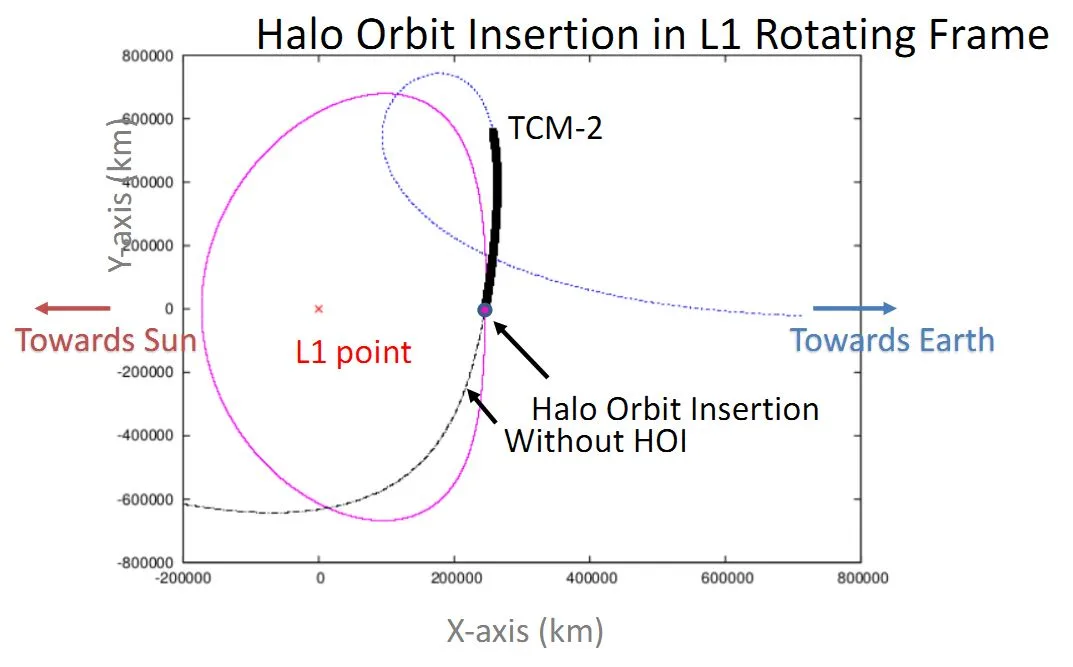Halo-Orbit Insertion (HOI) of its solar observatory spacecraft, Aditya-L1 was accomplished at 16.00 Hrs (approx) on January 6, 2024 (IST). The final phase of the maneuver involved firing of control engines for a short duration, according to the information on www.isro.gov.in
The orbit of Aditya-L1 spacecraft is a periodic Halo orbit which is located roughly 1.5 million km from earth on the continuously moving Sun – Earth line with an orbital period of about 177.86 earth days. This Halo orbit is a periodic, three-dimensional orbit at L1 involving Sun, Earth and a spacecraft. This specific halo orbit is selected to ensure a mission lifetime of 5 years, minimising station-keeping manoeuvres and thus fuel consumption and ensuring a continuous, unobstructed view of sun.
The Aditya-L1 mission is an Indian solar observatory at Lagrangian point L1 for “Observing and understanding the chromospheric and coronal dynamics of the Sun” in a continuous manner. Placing the Aditya-L1 in a halo orbit around L1 point has advantages as compared to placing in a Low Earth Orbit (LEO):
• It provides a smooth Sun-spacecraft velocity change throughout the orbit, appropriate for helioseismology.
• It is outside of the magnetosphere of Earth, thus suitable for the “in situ” sampling of the solar wind and particles.
• It allows unobstructed, continuous observation of the Sun, and view of earth for enabling continuous communication to ground stations.
Halo orbit insertion
The halo orbit insertion process commenced as the spacecraft crossed the XZ plane in the Sun-Earth- L1 rotating system, with the required orbital state. The insertion maneuver is essential to nullify the X and Z velocity components and attain the required Y-velocity in the L1 rotating frame for the required Halo orbit. The targeted Halo-orbit for Aditya-L1 is Ax: 209200 km, Ay : 663200 km and Az : 120000 km (The semi-axes of the 3-dimensional Halo orbit-refer figure).
The insertion of Aditya-L1 into this Halo orbit presents a critical mission phase, which demanded precise navigation and control. A successful insertion further involved constant monitoring along with the adjustment of the spacecraft’s speed and position by using onboard thrusters. The success of this insertion not only signifies ISRO’s capabilities in such complex orbital manoeuvres, but it but gives confidence to handle future interplanetary missions.
Aditya-L1 was designed and realised at UR Rao Satellite Centre (URSC) with participation from various ISRO centres. The payloads onboard Aditya-L1 were developed by Indian scientific laboratories, IIA, IUCAA and ISRO. The Aditya-L1 spacecraft was launched by PLSV-C57 on September 2, 2023 from SDSC SHAR, into an elliptical parking orbit (EPO) of 235.6 km by 19502.7 km. From here, Aditya-L1 embarked on an extraordinary journey towards the Sun-Earth-L1 Lagrange point, with the help of the onboard propulsion system, increased its orbital size progressively and moved toward L1 point. Five liquid engine burns (LEB) were executed during Earth orbit phase; gradually raised the apogee of the EPO in order to attain the desired trajectory with the fifth burn, known as the trans-L1 injection (TL1I) maneuver. The maneuver strategy is carefully devised to minimize incremental velocity addition (ΔV) for reaching the target L1 halo orbit while restricting the number of perigee passes to minimize the spacecraft’s exposure to the high radiation Van Allen radiation belts. To address errors during, TL1I phase, a short burn of the engines, called TCM-1 was conducted on October 5, 2023, and another TCM-2 on December 14, 2023 to ensure compliance with Halo orbit insertion condition parameters. The spacecraft underwent a cruise phase lasting approximately 110 days to achieve the present condition prior to HOI targeted on January 6, 2024.
All the payloads were tested during the pre-commissioning phase and performance of all the payload is confirmed to be satisfactory.

The picture shows the Halo orbit insertion process graphically in a two dimension picture. The Aditya-L1 spacecraft was moving from Earth towards the L1 point in the direction of Sun. The TCM1 &2 firing oriented the spacecraft toward the Halo Orbit, making it reach the HOI condition (which is a minimum fuel consumption condition) as on 6th January 2024 (Marked by the red dot). The final firing was done at this point, making the spacecraft align with the Halo Orbit. If the HOI manoeuvre was not conducted as done today, the spacecraft would have moved in the direction marked (Without HOI).






